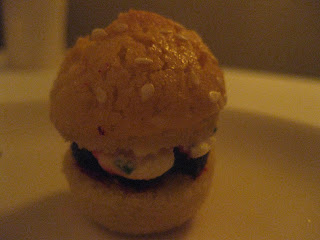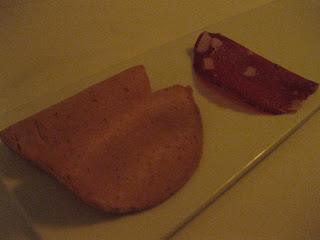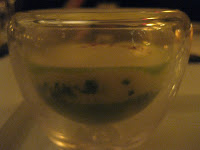To many, Manhattan would hardly be considered a haven for locavores. Known as a city of excess, many restaurants routinely source rare and exotic ingredients from across the globe with reckless abandon towards their carbon footprint. But a modest 45 miles outside the city, one restaurant has dedicated itself to these ideals and emerged as the country's farm-to-table mecca. Opening in 2004 in the confines of the Stone Barns Center for Food and Agriculture, Blue Hills at Stone Barns adopted the Center's emphasis on local and sustainable practices and incorporated them into a fine dining restaurant.
Spread across the 80 acres of land that formerly belonged to the Rockefeller Estate, are numerous greenhouses and pastures where animals run free, many of which the restaurant utilizes in the kitchen. Occurring in December, our meal at Blue Hill at Stone Barns was a snap shot of the season, incorporating absolutely sensational winter ingredients.
Arriving right on time for our reservation, MW and I regretfully were unable to tour the grounds and proceeded straight to the restaurant where we were promptly seated. The dining room, with high ceilings and exposed wooden beams reminded me of an elegant barn. In the center of the room was a large table with a wreath as its centerpiece, as well as various ingredients which were featured in our meal. Unlike most restaurants, diners have only two menu options: a five or eight course farmer's feast, each containing the same amount of food. Instead of listing the end product that comprised each course, we were presented with a sprawling list of seasonal ingredients which would be used throughout the meal. Having told our server that we had no dietary restrictions, we proceeded to order the eight course farmer's feast (supplementing a cheese course). To drink, we began with two glasses of Hermann J. Wiemar Dry Riesling, Finger Lakes, NY (2007).
Soon after, much to our delight, an army of servers bombarded our table with a bevy of amuse bouches sent from the kitchen. Whereas vegetables often play a supporting, or worse, forgotten role at many restaurants, here at Blue Hill they are (deservingly) featured as the star ingredient in many dishes. Rarely do you encounter ingredients so good that the chef has the utmost confidence in presenting them virtually untouched. But that is exactly what Chef Dan Barber gave us as our initial amuse. Appropriately called, "Vegetable Fence," bite-sized pieces of Cauliflower, Edamame, Broccoli and Carrots sat on spikes which protruded from a rectangular wooden block, thus creating the illusion of a "fence." Seasoned ever so slightly with salt that emphasized their natural sugars, eating these reminded you just how good perfectly ripe vegetables can be by themselves. This course proved to be a symbolic foreshadowing to our meal ahead.
Our next amuse, "Vegetable Tower," featured several vegetable chips. Perched on multiple tiers of a vertically standing wooden block were Purple Peruvian Potato Chips woven with a single sage leaf, Forono Beet Chips and chips made from Smoked Black Tuscan Kale. Just as the vegetables from the previous course established a "baseline" of sorts reestablishing how they taste in their natural state, this course was a study in concentrated flavors. By dehydrating, and not frying these chips, Chef Barber simultaneously maintained the integrity of each vegetable while also ratcheting up the flavor quotient. My favorite of the three was the kale, which contained a pleasantly faint smokey taste.
Next, were pieces of Salsify wrapped in House Made Prosciutto. Skewered on the ends of long sticks, these reminded me of vintage television antenna, albeit, much tastier. Another great combination, utilizing the saltiness of the prosciutto to enhance the the sweetness of the salsify, this was yet another course which featured root vegetables.
Following these were two Bite-Sized Beet "Burgers," which displayed Chef Barber's playful side. A mixture of Beets and Goat Cheese were sandwiched in-between a miniature Brioche Bun, complete with sesame seeds. Appearances aside, the flavor alone proved as memorable as the combination of sweet beets, tangy goat cheese and buttery brioche just may have been the best single bite of the entire meal.
A leaf of Romaine Lettuce with Chickpeas was easily the weakest of our amuses. While I appreciated the idea of combining the crisp texture of the lettuce with the creaminess of the chickpeas, this course just fell short on flavor.
House made charcuterie? Yes please! We were treated to slices of House Made Bologna and Speck, both of which came from Blue Hill's own Berkshire pigs. Although I was never fond of bologna growing up, rest assured, this is nothing like that processed crap from Oscar Meyer and was actually quite enjoyable. Meanwhile, the speck was so fantastically fatty and flavorful, it had me wishing my school lunches were made with these thin slices of porky goodness.
By this point our table was embarrassingly cluttered from all our amuses. Fortunately, the Frittata covered with House Made Prosciutto brought an end to this madness. Made from eggs taken right from the farm, the frittata was a much more vibrant yellow than anything I've seen. Together, the salty ham and delicate egg culminated into another memorable bite.
Bread service was nothing short of excellent. A basket of warm Caramelized Onion Potato Bread, made by Balthazar Bakery but finished at Blue Hill, was accompanied by Unsalted Cow's Milk Butter from Ronnybrook Farms Dairy, House Made Ricotta Cheese and a Porcini Mushroom Salt. The bread was very good, having a crusty exterior but soft middle, it was even better with the fresh butter. Sadly, the ricotta reminded me of runny cottage cheese, was far too mild for the bread, requiring a liberal amount of porcini salt to season.
Our first actual course was Big Eye Tuna from Long Island with Honey Crisp Apples and Paddlefish Caviar. Slices of raw tuna, thicker than most sashimi, were stacked next to tiny matchsticks of apple and surrounded by caviar. The tuna was impeccably fresh and was a good match with the sweet apple and briny caviar. This dish easily trumped any tuna tartare.
Before our next course, we were approached by our server holding a brunch of raw carrots. Looking as though they had just been plucked the ground (still containing a good amount of soil) she explained how during the winter months root vegetables, such as these carrots, go into survival mode, storing as much residual sugar as possible, making for the best tasting carrots possible. Officially described as a Roasted Mokum Carrot topped with Spiced Breadcrumbs over a Carrot Purée, you better have one damn good carrot if you plan on serving it as the featured ingredient of the course. But I will never doubt Chef Barber when it comes to knowing his vegetables and after tasting this dish, I will surely never view carrots in the same way as before. Chef Barber was able to transform this carrot into something substantial and deeply satisfying, coaxing both savory and sweet flavors from the vegetable. Sometimes it takes a transformative dish such as this to change your perception of what a carrot can be, evolving your perception from simply rabbit food to a signature dish.
Next was Maine Shellfish with Potato and Spinach Purée. Large chunks of Lobster, Scallop and Clam sat in a pool of Spinach Purée that had been fortified with Potato. The interplay between the sweet shellfish and the comforting spinach-potato mixture was especially welcome on a cold December night such as this.
Our server then made her way to our table once again, this time holding a plastic bowl full of eggs that had been gathered earlier that day. Later, she presented us with a Farm Fresh Egg over Lentils in a Lettuce Broth with Pea Tendrils. Already having been impressed with the frittata earlier, this egg was soft poached, nestled atop a bed of soft lentils and covered in a frothy lettuce broth with some pea tendrils contributing a textural contrast. Like the carrot before, the egg is also an often overlooked ingredient. Yet it was with these two rather unassuming items where Chef Barber was at his best, taking an already superb ingredient and doing as little as possible with it, allowing its quality to speak for itself.
The Berkshire Pork Belly with Romano Beans was heaven on a plate. Fork tender, the pork contained a pleasant meat-to-fat ratio and remained juicy and moist. The unctuous pieces of belly meat and soft beans were great together and paired wonderfully with our glasses of Blue Hill and Hirsch Vineyards Pinot Noir, Sonoma Coast California (2007).
Moving to our final savory course, Veal with Celery Root, Bordaeux Spinach, Parsnip Purée and Radish was technically flawless, yet paled in comparison to the stronger flavors of the previous course. However, the caramelized celery root and parsnip puree provided a very good sweetness to the perfectly cooked veal.
We decided to supplement a Cheese Course and received a Cow's Milk Cheese, paired with a House Made Marshmallow and a Sheep's Milk Cheese, paired with Quince Paste. Eaten with toasted slices of Whole Wheat Brioche, we thoroughly enjoyed the mild sheep's milk cheese with quince but found the cow's milk cheese much too grassy and though the marshmallow pairing to be unappetizing.
Our first dessert was Seckel Pear with Flaxseed and Gingerbread. The pear was transformed into a sorbet which accompanied a flax seed cake that had been sprinkled with gingerbread crumbs. The dessert was wonderfully refreshing and was an excellent segue to our final dessert.
The final dessert was Cranberry with Sweet Potato Cake topped with Pink Rose Apples and Cinnamon Ice Cream. As with our first dessert, Pastry Chef Alex Grunert was able capitalize on the ingredient's natural sweetness-- negating any possibility of them being cloyingly sweet or too heavy.
Along with the our check we were presented with a few Petits Fours: Flaxseed Caramels, Gingerbreads and Dark Chocolate Truffles. We leisurely noshed on these as we wrapped up our meal and headed for the door. In addition to our coats, we also received a complimentary Holiday Stollen as a parting gift, which went incredibly well with a triple cream goat cheese back home.
Having already earned countless accolades and praise, Chef Barber continues to masterfully incorporate his farm-to-table philosophy into a truly one of a kind dining experiences. Called by some "the world's most important restaurant" for its inspirational emphasis on local ingredients, sustainable practices and world-class food, Blue Hill at Stone Barns provides much more than simple nourishment, its an opportunity allowing diners a chance to become intimately familiar with the food they will consume. Just as Blue Hill at Stone Barns reaps the perpetual rewards from their bountiful gardens, so too does the restaurant benefit from their enlightened clientele who return time and time again for this "organic" approach to food, proving once again, you really do reap what you sow.
Blue Hill at Stone Barns
630 Bedford Road
Pocantico Hills, New York 10591
(914) 366-9600
http://www.bluehillfarm.com/home
To see all our pictures click the flickr link.














































Your post makes me really want to go for dinner. The farmer's lunch was nice, but your dinner looks amazing.
ReplyDeletealthough every rising chef these days has his/her own carrot dish, DB's carrot stole the show for us on our last visit as well.
ReplyDeletelove the blog, keep them coming
-jbm
I thought it was going to be some boring old post, but it really compensated for my time. I will post a link to this page on my blog. I am sure my visitors will find that very useful. carports in Brisbane
ReplyDelete